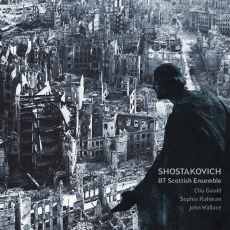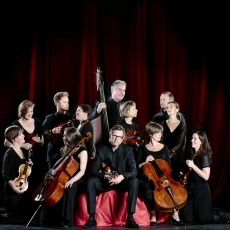Shostakovich - Scottish Ensemble - The Times
3 out of 3 stars "worth buying"
In the string pieces, this is, simply, one of the best recordings I've ever heard: a crystalline reproduction of a chamber orchestra, without apparent electronic mediation. Individual instruments emerge with pinpoint definition in pellucid detail, but not at the cost of ambience (most clearly evident in the glow around the solo trumpet). The clarity and focus in the bass are breathtakingly "natural" - no low-end pre-emphasis à la Decca - with positive results for the overall sonic frame: the chordal punctuations in the Chamber Symphony, for example, are crisp as well as vividly resonant.
Fortunately, the expert BT Scottish Ensemble thrives under the scrutiny. (Yes, the name betokens British Telecom's sponsorship -- another one of those standing corporate ads, like the "RCA Dome" and the "Brendan Byrne Arena.") It's a small ensemble: twelve players, with just a pair each of violas and cellos, which could present tuning problems. But their intonation is bullseye-accurate; their tone firm, warm, and evenly balanced; and their ensemble tight. And clearly they focus, not just at solving technical problems, but at penetrating to the music's expressive core as well.
The Chamber Symphony, Rudolf Barshai's amplification of the Eighth Quartet for string orchestra, sounds more intimate, more in touch with its roots, than usual -- like "scaled-up" chamber music. (By comparison, Barshai's own, hardly inflated, reading with the Chamber Orchestra of Europe, DG 429 229-2, sounds positively massive.) The BT players wisely don't allow their posh, cultivated sound inappropriately to glamorize the music. The outer movements are full and vibrant, intensified but not overwhelmed by the added instruments. The scherzo is vigorous and virtuosic; the third movement's opening theme becomes an elegant, grotesque waltz; the fourth's sustained passages mesmerize the ear, evoking broad, bleak landscapes.
The reduced forces also bring a fresh slant to the Concerto. Larger ensembles underline the spiky rhythms; the BT, without sacrificing accuracy or drive, projects them with a softer edge and an undulating buoyancy. (The upper strings sound granulous in the Lento's soft chorale.) The soloists are excellent. Sophia Rahman's pianism is articulate and limpid; she's a bit too "present" in the balance, but still manages to evoke bittersweet nostalgia in the waltz at 6:06 of the Lento. John Wallace's trumpet, better placed within the texture, keeps every note of the driving staccatos round and pillowy. In the Lento solo, he welds a cornetlike legato with precise note-to-note control, fashioning an austere lament while avoiding mawkishness; and he dominates the concerto's closing pages resplendently.
With the two octet pieces, the BT players land in their real mÈtier. Their full, rich chording at the start made me want to hear them in Mendelssohn's Octet; later on, they realize the half-tints beautifully. The second piece goes with a lithe, driving energy and stunning accuracy, a touch of slurriness in the accompaniments notwithstanding.
Compliments to the producers for thoughtfully providing a generous pause (fourteen seconds) between the Chamber Symphony and the Concerto, giving the symphony's ending time to fade from the mind
ClassicalCDReview.com
Clio Gould's BT Scottish Ensemble is a group of 12 highly talented string players and as such it would be difficult to think of an ensemble better suited to Shostakovich's Chamber Symphony in C minor, Op110a. The work is an arrangement, by Rudolf Barshai, of Shostakovich's bleak Eighth String Quartet, written when the composer was on the verge of suicide.
In full orchestral fig, it can seem too monumental, too universal an expression of grief, but an ensemble of 12 players is able to capitalise on the extra power without sacrificing the sense of personal suffering. The anger of the second movement is well focused in this superbly engineered recording.

